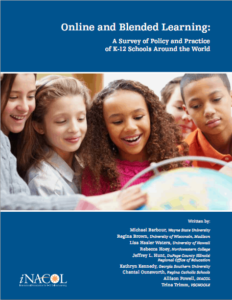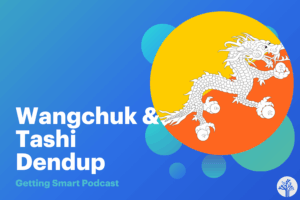Review: iNACOL’s Online & Blended Learning Survey

At the 2011 Virtual School Symposium (VSS) in Indianapolis, the International Association for K-12 Online Learning (iNACOL) released the report Online and Blended Learning: A survey of Policy and Practice of K-12 Schools Around the World, which showcases the ways that new technologies and learning models have accelerated across the globe.
The authors worked with researchers in more than 60 countries to deliver 50 completed surveys that covered 23 questions on funding, students, professional development, quality assessment, challenges, and technology (4).
The report first outlines the models of online and blended learning, which include asynchronous learning, blended learning, content repository, digital learning, distance education, face-to-face, online course, online learning and synchronous learning (7-8). Then, it travels from country-to-country to outline specific case studies, facts and information unique to each location.
Key findings from the report identify five major trends and prominent challenges from the surveys (9-22). The trends include:
- “Blended and online choices are most available to students in urban areas from developed countries.”
- “Growth in digital learning stems from shared authority between local schools and national governments.”
- “Specialized teacher training is not required but is encouraged and available.”
- “Blended learning is occurring with much greater frequency than online learning.”
- “Use of online learning is most prevalent by students with special circumstances (10-14).”
- “A lack of knowledge about online learning.”
- “Sporadic interest in online learning.”
- “Illiteracy and access to technology.”
- “Lack of funding.”
- “Lack of governmental vision and leadership (18-20).”
- Sixty percent of countries surveyed reported government funding for online or blended learning.
- Twenty-five percent of countries surveyed require teacher training for online learning.
- China’s first online school was created in 1996; today it has expanded to more than 200 online schools with enrollments exceeding 600,000 students.
- Seventy-two percent of the surveyed countries reported that their online and blended classroom teachers participated in professional development for online teaching.
- Universities and colleges were reported as the primary source of training for educators, followed by regional centers and local schools.
- In British Columbia, online schools provide complete programs or individual courses to 71,000 students, which is about 12 percent of the student population.
- In 2010, Hong Kong enacted a policy recommendation for digital learning that “debundled” textbooks and teaching materials to make them more affordable and accessible to schools, and accelerated the development of an online depository of curriculum-based learning and teaching resources. A pilot scheme later resulted in a program made available to all 410,000 primary and secondary students in 300,000 low-income families—especially the 8 percent without Internet access at home—to gain access to the Internet for the purpose of learning.
Online and Blended Learning was written by Michael Barbour, Regina Brown, Lisa Hasler Waters, Rebecca Hoey, Jeffrey L. Hunt, Katheryn Kennedy, Chantal Ounsworth, Allison Powell and Trina Trimm. Click here to view the full report. For more visit inacol.org.






luis
Computers are only assistants and a good teacher’s will always be needed. However social networks such as facebook and YouTube as well as great resources including Wikipedia and Wolfram-Alpha are here to stay so that educators must use them in the teaching process. Many academics are posting great educational videos and materials online.
The only problem is to sort the good ones from the rest and present them in an organized manner.
This effort is being done by: http://Utubersity.com which presents the best educational videos available on YouTube in an organized, easy to find way to watch and learn.
They are classified and tagged in a way that enables people to find these materials more easily and efficiently and not waste time browsing through pages of irrelevant search results.
The website also enhances the experience using other means such as recommending related videos, Wikipedia content and so on. There's also a Spanish version called http://utubersidad.com
This is a project that YouTube should embrace itself, with curated content from academics and maybe using a different URL (Youtubersity?) so it won’t be blocked by schools.
Paul W. Bennett
The International Association of K-12 Online Learning (iNACOL) has just released two major reports on the State of Online Learning in the world and here in Canada. Dr. Micheal K. Barbour (Assistant Professor, Wayne State University, originally from Newfoundland) is the lead researcher and, in my opinion, produces reports that present a rather rosy picture of the situation.
The November 2011 international report bears close scrutiny because of the scope of the study and the difficulty in trying to analyze online learning in countries like Canada with 13 different authorities (provinces and territories) responsible for education.
In the case of Canada, British Columbia is the chosen example. That is a peculiar decision because that province is totally unrepresentative of the state of online learning in Canada. Indeed, using BC is downright misleading because it paints a tremendously glowing picture of the state of online learning across Canada.
How do I know? Because I was hired by the Canadian Society for Quality Education (SQE) in early 2011 to conduct an independent study of the Sate of Online Learning in Canada, essentially reviewing past INACOL reports and digging deeper into the findings.
My independent research study, for SQE and the Atlas Economic Foundation, “THE SKY HAS LIMITS”:ONLINE LEARNING IN CANADIAN K-12 PUBLIC EDUCATION” (April 28, 2011) reached significantly different conclusions about the state of online learning here in Canada.
Here’s a brief summary of my findings:
“A comprehensive analysis of online learning, drawing upon recent authoritative research studies, provincial websites and reports, and key interviews reveals that the promise of online learning remains largely unfulfilled in K-12 education. In spite of the tremendous advantages afforded by introducing online learning programs, significant barriers stand in the way of its natural growth and expansion. In all of Canada’s provinces and territories, including Alberta, school choice is rationed or channelled, learning conditions are carefully state regulated, and the delivery of education limited by teacher union contracts. Some private sector virtual schools have recently arrived, but no online public charter schools exist, even in Alberta, the only province with Charter School legislation. Distance education and online learning student enrollments are growing only modestly, given the limits imposed by structural impediments, regulatory constraints, and – in some “have not” provinces – by budgetary restraint programs.”
Dr. Barber’s Canadian Online Learning report is even more skewed than the Canadian section of the international study. In his 2009-10 Canadian iNACOL report, Barber cited the Nova Scotia Teachers Union and its contract as as a clear obstacle to online learning, yet his newest report cites the NSTU as being exemplary… How could it be that the NSTU, formerly described as the prime obstacle.. is now hailed for setting a good example?
What’s my point? The iNACOL reports, prepared by Michael Barbour and his colleagues, should not be accepted as the definitive word on the state of online learning in Canada and perhaps in other nations. It’s still an immature field of educational research and one that is too important to be left to the “techies” alone.